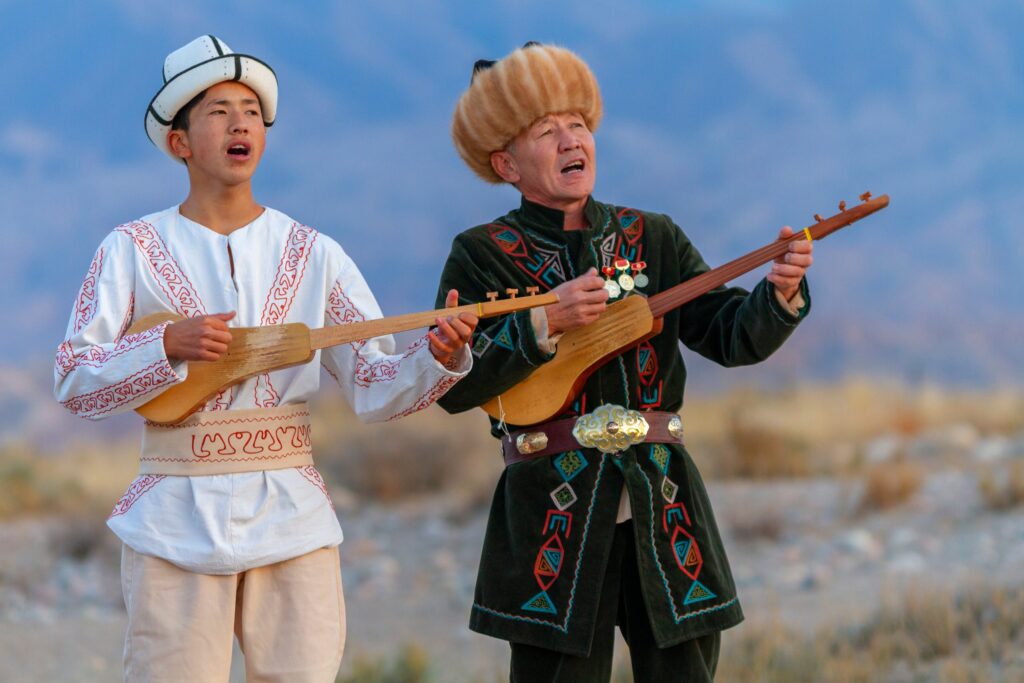Explore the wonderful and peaceful genre from Central Asia.
Music of the Nomads
The Kyrgyz people are a nomadic Turkic ethnic group from Central Asia. They are claimed to be the descendants of the 40 tribes Manas united over a millennia ago to fight off the Khitan people. The epic of Manas and its stories of the hero’s battles against groups like the Uyghurs, Chinese, and Afghans is a nationally loved oral history of the country’s people and one of the longest epic poems in the history of humankind. Their folk songs have long been musical renditions of the epic’s stories and pillars to keep the Kyrgyz people united amongst centuries of occupations by various groups.
In addition to the historical Manas-inspired songs Kyrgyz folk music also reflects on the land and nature of the region. As nomadic people throughout most of their history the Kyrgyz have made music about coexistence with and appreciation of the region’s green expansive valleys and light blue lakes. Their music also touches on the country’s largely mountainous terrain and gorgeous long basins. These are songs filled with wanderlust and movements. There is a humble perception of their place in the world and the power of things outside of human control.
Instruments
Throughout the history of the Kyrgyz people manaschi’s (more universally known as shamans) would travel throughout the region and play popular music. There were essential instruments that they used during their performances. For Kyrgyz folk, the music is meant to express feelings and emotions that words can’t. The music is heavily complementary to the singing. With it, the listener experiences the full breadth of emotions and passions from the performer. Some of the standout instruments in Kyrgyz folk are the Komuz, the Sybyzgy, and Kyl Kiak.
The Komuz is a chord-based instrument that resembles the guitar. Veteran players can use the Komuz in outright theatrically and wonderfully eye-grabbing ways. The fast playing and altering positioning fill the listener with exhilaration. The Komuz is an incredibly dynamic instrument that takes on different approaches and sounds depending on the musician’s will and ability. Imagine, a short guitar that could be played upside down non-ironically.
The Sybyzgy is a side-blown flute made of carefully crafted apricot or mountain bush wood. The instrument sounds like the mystical winds from the Tian Shan mountain range. Listening to an expert Sybyzgy is an unbelievably calming experience. Typically, the player will perform on a chair and hold the Sybyzgy with both hands downwards. At 2 feet long it is a sight to observe. The Sybyzgy is played in a deeper pitch than a traditional flute and contains raspy tonal transitions and relaxing tones.
The Kyl Kiak is a string based instrument that is reminiscent of a viola. The sound of this instrument is painfully morose and saddening. These strong feelings expressed through the Kyl Kiak make it the perfect background for more serious events and stories. Across Kyrgyz culture, the people realize the player must have real and authentic emotions to express when playing the Kyl Kiak. The instrument will reveal the emotional emptiness of the player if they are not playing from the heart.
How Does it Sound?
The music reflects the calming landscape of green steppes, white mountains, and blue lakes. Kyrgyz folk was developed by nomads and it contains the mystical sense of wanderlust and exploration. It’s meditative music. You can easily be transfixed by the antiphonal singing and long sustained tones.
Competition akyn’s feature two singers displaying their lyrical talent, ear for melody, and observations about their opponent to the audience. The akyns sound very much like rap battles. The lyrics are both comedic and offensive. The singer’s perform with exciting energy and unexpected bravado. Also, men and women compete against one another indiscriminately.
Some of the street music contains the airy nostalgia that we associate with folk. The lead singer is usually pretty composed and relaxed as they sing about past relationships and nature. These performances pull you in with their compelling sounds and auras.
Modern Kyrgyz Music
Music in Kyrgyzstan is beautifully varied and multicultural. They are using influences from K-Pop, metal, and their own past to revive old music and create new ones. Some of the standout musicians from Kyrgyzstan right are Rysbek Jumabayev, Jonele, Birai, and Darkestrah.
The neo-traditionalist Rysbek Jumabayev is keeping the Manas epic and history of Kyrgyzstan alive. Not only does he perform around the country but he takes trips across the world to spread the epic’s stories. His live renditions of the Manas classic’s are filled with immersive humming, singing, and body movements. He is really engrossed in the performances and the commitment shows.
KG-Pop music is the latest pop-styled genre from the nation. Acts like Birai and Jonele sound and look remarkably like popular K-Pop acts (think BLACKPINK and BTS). Birai’s music reflects the synth pop, distorted horns, and rap-sing delivery of modern popular music. Meanwhile, Jonele is excitingly colorful and flamboyant. The production on their songs sound delightfully polished and crisp. Their sound feels resoundingly like now.
Darkestrah has a little over 2 decades of experience and remarkably unites black metal with Kyrgyz folk music. They are currently based in Europe and have found a committed international audience outside of their origins in Bishkek. While the music is incredibly dense and haunting sometimes it does capture a lot of the spirit and memories of Manas’s epic.
While the region gets overlooked in many ways the music captured in the country is far from forgettable. The music can be thrilling, saddening, hopeful, and downright euphoric. Their music is directly linked to their culture, national pride, and history. It is an amazing experience to dive deep into the live performances, modern experimentations, and Manas-inspired stories. To understand Kyrgyz folk is to understand the Kyrgyz people’s.
Source: Medium


